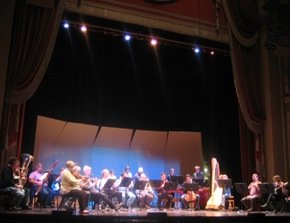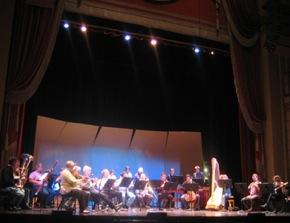
The San Francisco Contemporary Music Players celebrated its 40th anniversary in style this past Monday at the Herbst Theatre, bringing together hundreds of adoring friends to hear a wide range of music, all done very well. Befitting the occasion, the program included many elements emblematic of this group, from a modern classic, to two works of the contemporary European scene with which the group has a special affinity, and a world premiere written for the Players by one of the ensemble’s founders. Every piece on the program had a distinct sense of invention, a self-defining style, and a series of strong performances served each work well.
Before the group launched into the music, the stage was taken by its three founders, all of whom played important roles in the ensemble’s growth over the years: conductor Jean-Louis LeRoux, harpist Marcella DeCray (who became the Players’ first Executive Director), and composer Charles Boone. The talk ranged from reminiscences of their early Bring Your Own Pillow gallery concerts to moments of crossing paths with musical eminences from Toru Takemitsu to Frank Zappa. The continuity with the group’s history, the sizable crowd and warm spirit in the air — it all served to celebrate not only the group’s musical achievements, but their success in growing a community around the ensemble’s work.
The program began with the world premiere of Boone’s Elementary Particles, Part I, for two violins. This is a work of 21 short sections, with the violins essentially mirroring each other in quasi-canonic style, proceeding slowly, patiently exploring the instrument’s possibilities. Most of the imitation was between spare notes and gestures — a glissando, a microtonal bend, or intense vibrato rather than longer figures. Boone’s spare approach didn’t always work over the piece’s 20-minute span, but at its best, the work was quietly compelling, slowing time down until the piece took the form of a musical still life. The performance by Roy Malan and Susan Freier was a model of focus and commitment.
Salvatore Sciarrino’s Il silenzio degli oracoli (The silence of the oracles), from 1989, is a brief, driving work for wind quintet, though it hardly registers as a work for that particular ensemble, instead inhabiting a sound world distinctly its own. Nearly every sound in this work is produced by extended techniques — key clicks, unpitched breathing through the instruments, and so on, and it builds in intensity through the consistent surprise of its instrumental effects, its rhythmic momentum, and its stark silences. Conductor Sara Jobin led an incisive performance.
Like the Sciarrino piece, the Swiss-German composer Beat Furrer’s 1988 work Spur (German for "trace") is played by a conventional ensemble — piano, 2 violins, viola, and cello — but calling the work a piano quintet would connect it to a tradition from which it stands apart. From the start, the music builds tremendous rhythmic momentum and refuses to let up, but its rapid gestures are articulated by string players barely touching the strings, and the piano is played with a skimming, ghostly touch. A couple of minutes into the piece, longer bowings are introduced, but just barely, and the touch on all instruments remains largely percussive as the players weave around each other. The effect is one of murmuring, fascinating intricacy, its momentum only amplified by the occasional bursts of silence that break through. Only at the very end of the work, in what seemed a misstep to me, did Furrer break away from this approach and drop off into a more spacious, but less rhythmic approach, breaking the spell that the driving music preceding it had cast. Jobin led a razor-sharp performance that had both the energy and clarity the music called for.
The program’s second half was given over to the only piece older than the ensemble itself, but one that shares Bay Area roots, Terry Riley’s In C. The players expanded to chamber orchestra size, filling out to 21 players with the addition of two of David Tanenbaum’s students on electric guitar, and four of William Winant’s students on mallet percussion. Winant himself served as the ensemble’s leader, introducing each of the piece’s 53 melodic fragments for the ensemble to follow in successive waves. With the piece designed to be different every time it’s played, each performance has its own rewards. From where I was sitting at Herbst, I especially enjoyed the moments in this 40-minute rendition when the low brass and bassoon crescendoed to create a cushion for the beautiful sound masses that hovered above them, but I imagine the ensemble revealed different colors and details throughout the hall. This was a rich, often transporting performance, and a splendid way to end the celebration.

